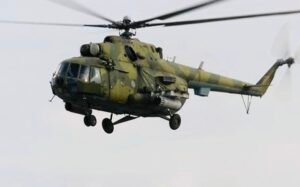Russian Mi-8T Helicopter Disappears: Search and Rescue Operations Underway

A Russian Mi-8T helicopter carrying 22 people has gone missing in the remote Kamchatka Peninsula in the Far East of Russia. The helicopter, which included 19 passengers and 3 crew members, was reportedly en route from a base near the Vachkazhets volcano when it lost contact with air traffic control. The incident has prompted a large-scale search and rescue operation, as authorities scramble to locate the missing aircraft and its occupants.
Background on the Mi-8T Helicopter
The Mi-8T is a variant of the Mil Mi-8, one of the most widely used helicopters in the world. Originally developed in the Soviet Union in the 1960s, the Mi-8T is known for its versatility and durability, commonly used in both military and civilian operations. The helicopter is often employed in challenging environments, such as those found in the remote and rugged regions of Russia. Its ability to operate in harsh conditions has made it a workhorse for Russian aviation, especially in areas like Kamchatka, where access by road is often impossible.
The Incident
The Mi-8T helicopter in question took off on a routine flight across the Kamchatka Peninsula. However, shortly after takeoff, the aircraft lost communication with air traffic controllers. The helicopter was expected to land safely at its destination but never arrived. When the helicopter failed to make contact at the scheduled time, concerns were raised, and a search and rescue mission was immediately launched.
Initial reports indicate that the helicopter was operated by Vityaz-Aero, a regional airline that frequently operates in the Far East of Russia. The aircraft was reportedly conducting a civilian flight, although details about the passengers and the purpose of the flight have not been fully disclosed.
Challenges in the Search and Rescue Effort
The search for the missing helicopter is complicated by the challenging terrain of Kamchatka, a region known for its volcanic activity, dense forests, and unpredictable weather conditions. The peninsula is one of the most remote areas in Russia, with vast stretches of wilderness that are difficult to navigate. The ongoing search is being hampered by poor weather, including low visibility and strong winds, which are typical for the region.
Russian authorities have deployed both ground and aerial search teams, including helicopters and drones, to comb the area for any signs of the missing aircraft. However, as of now, there has been no contact with the helicopter, and its location remains unknown.
The search and rescue teams are racing against time, as the chances of finding survivors decrease with each passing hour. The rugged terrain and severe weather conditions further complicate the mission, making it a challenging and dangerous operation for the rescuers involved.
Past Incidents and Safety Concerns
This incident is not the first time a helicopter has gone missing in Russia’s Far East. The region’s harsh weather and difficult terrain have been the backdrop for several aviation accidents over the years. In many cases, helicopters have crashed due to poor visibility, mechanical failure, or pilot error, leading to significant loss of life.
The safety of helicopters operating in remote areas has been a topic of concern, particularly regarding older models like the Mi-8T. While the Mi-8T is known for its reliability, the aging fleet of helicopters in Russia has raised questions about maintenance and safety standards. The exact cause of this latest incident remains unknown, but it has renewed discussions about the risks associated with operating in such challenging environments.
The Human Impact
The disappearance of the Mi-8T helicopter is a stark reminder of the dangers faced by those who live and work in Russia’s remote regions. The passengers on board, whose identities have not been fully revealed, are at the center of a desperate search effort. Families and friends of the missing individuals are anxiously awaiting news, hoping for a positive outcome despite the challenging circumstances.
As the search continues, the incident has captured the attention of both national and international media. The world is watching as Russian authorities work tirelessly to locate the missing helicopter and bring its passengers to safety. The situation remains fluid, and updates are expected as more information becomes available.
Conclusion
The disappearance of the Russian Mi-8T helicopter highlights the inherent risks of aviation in remote and challenging regions like the Kamchatka Peninsula. While the outcome of the search and rescue mission remains uncertain, the incident underscores the importance of safety, preparedness, and swift response in the face of such emergencies. The thoughts and prayers of many are with the passengers and crew, as efforts continue to bring them home safely.
Also read:




